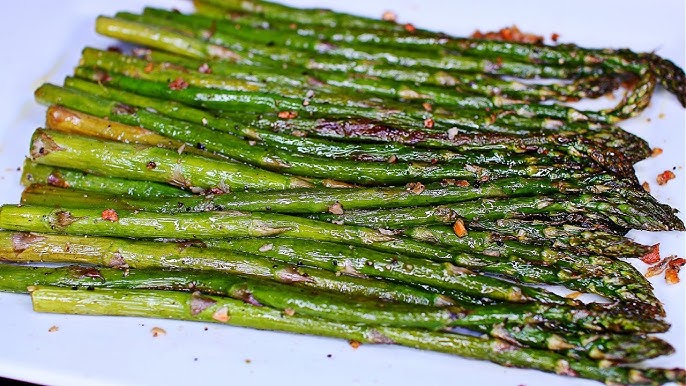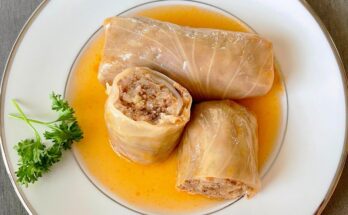Baked Asparagus Recipe: Baked asparagus is one of the simplest yet most elegant side dishes you can prepare. It complements a variety of main courses, from grilled chicken to salmon, making it incredibly versatile. Its crisp-tender texture and rich flavor profile are enhanced when roasted in the oven, turning it into a crowd-pleasing dish for family dinners and holiday gatherings.
Asparagus isn’t just tasty—it’s also quick to prepare, making it perfect for busy weeknights. Whether you’re a beginner or a seasoned cook, this guide will walk you through every step to ensure your baked asparagus turns out perfect every time.
Nutritional Benefits of Asparagus
Asparagus is a powerhouse of nutrients. It’s low in calories yet packed with fiber, vitamins A, C, E, and K, and folate. These nutrients promote healthy digestion, boost immunity, and improve skin health.
One of asparagus’s standout benefits is its high antioxidant content, which helps combat inflammation and oxidative stress. It’s also a great source of potassium, which supports heart health and reduces bloating.
If you’re watching your weight or aiming for a low-carb diet, baked asparagus is an ideal choice. It’s naturally gluten-free and keto-friendly, making it suitable for almost any dietary preference.
Ingredients and Tools Needed
Essential Ingredients for Baked Asparagus
To create the perfect baked asparagus, you’ll need:
- 1 lb (about 1 bunch) of fresh asparagus
- 2–3 tablespoons of olive oil
- 2 cloves of garlic, minced
- 1 teaspoon of salt
- ½ teaspoon of black pepper
- 2 tablespoons of grated Parmesan cheese (optional)
- 1 lemon, sliced (optional for garnish)
- Red pepper flakes (optional for a spicy twist)
Optional Seasonings:
- Paprika
- Italian seasoning
- Fresh parsley or thyme
Kitchen Tools You’ll Need
Gather these tools before starting:
- Baking sheet or tray
- Parchment paper or aluminum foil for easy cleanup
- Sharp knife for trimming asparagus
- Mixing bowl
- Measuring spoons
- Tongs or spatula for tossing and arranging
Having the right tools ensures your preparation process is smooth and mess-free.
Preparing Asparagus for Baking
How to Select Fresh Asparagus
When choosing asparagus, look for:
- Bright Green Stalks: Fresh asparagus should have a vibrant green color with firm stalks.
- Tight Tips: The tips should be compact and not mushy.
- Uniform Thickness: Opt for medium-thickness stalks, as they bake evenly compared to very thin or thick ones.
Avoid stalks that are wilted, soft, or have an unpleasant smell, as these are signs of aging.
Cleaning and Trimming the Asparagus
- Rinse Thoroughly: Wash the asparagus under cold running water to remove any dirt or grit.
- Trim the Ends: Bend the stalk near the bottom until it naturally snaps. This removes the woody part. Alternatively, trim about 1–2 inches off the bottom using a knife.
- Pat Dry: Use a paper towel to dry the asparagus completely. This helps the oil and seasonings stick better.
Once prepped, the asparagus is ready for seasoning and baking.
Seasoning Variations for Asparagus
Classic Garlic and Parmesan Flavor
- Toss asparagus in olive oil, minced garlic, salt, and pepper.
- Sprinkle grated Parmesan cheese just before baking for a cheesy, savory touch.
Lemon and Herb Twist
- Coat with olive oil, fresh lemon juice, and zest for a tangy flavor.
- Add herbs like parsley or thyme for freshness.
Spicy Chili and Paprika Option
- Mix olive oil with chili flakes, paprika, and cayenne pepper for a bold and spicy kick.
- Top with a dash of smoked salt for extra depth.
Step-by-Step Baking Instructions
Preheating the Oven – Temperature and Setup
- Preheat your oven to 400°F (200°C).
- Line a baking sheet with parchment paper or foil for easy cleanup.
Arranging Asparagus on the Baking Tray
- Spread the asparagus in a single layer to ensure even roasting.
- Drizzle olive oil over the stalks and toss to coat evenly.
- Season with salt, pepper, and any chosen spices or herbs.
Monitoring Cooking Time and Texture
- Bake for 12–15 minutes until the tips are slightly crispy but the stalks remain tender.
- For thicker asparagus, increase the cooking time by 2–3 minutes.
- Check for doneness by piercing with a fork—it should slide in easily.
Serving Suggestions
Pairing Asparagus with Main Courses
Baked asparagus is a versatile side dish that pairs beautifully with many main courses. For a well-balanced meal, consider serving it with:
- Grilled Chicken or Turkey: The smoky flavors complement the lightness of asparagus.
- Baked or Pan-Seared Salmon: The richness of salmon pairs perfectly with the crisp-tender asparagus.
- Steak or Pork Chops: Asparagus provides a refreshing contrast to heavier meats.
- Pasta Dishes: Add it as a side or mix it into creamy pasta for extra texture and flavor.
- Vegetarian Mains: Serve it alongside stuffed bell peppers, risotto, or quinoa bowls.
Garnishing Tips for an Elegant Presentation
To make your baked asparagus look as good as it tastes:
- Lemon Wedges: Place a few lemon slices around the plate for a pop of color and added zest.
- Fresh Herbs: Sprinkle chopped parsley, thyme, or basil on top for a touch of green.
- Parmesan Shavings: Garnish with extra Parmesan right before serving for a cheesy, savory finish.
- Drizzle of Balsamic Glaze: Add sweetness and acidity to complement the earthy flavors.
By adding these final touches, you can make your asparagus dish look restaurant-worthy while enhancing its flavor profile.
Storage and Reheating Tips
How to Store Leftover Baked Asparagus
If you have leftovers, here’s how to keep them fresh:
- Cool Completely: Allow the asparagus to cool before storing to prevent sogginess.
- Refrigerate: Place in an airtight container and refrigerate for up to 3–4 days.
- Separate Layers: If stacking in the container, place parchment paper between layers to prevent sticking.
Avoid leaving asparagus at room temperature for more than 2 hours, as this may lead to bacterial growth.
Reheating Without Losing Texture
When reheating baked asparagus, the goal is to maintain its crispness. Here are the best methods:
- Oven Method:
- Preheat the oven to 350°F (175°C).
- Spread asparagus on a baking sheet and heat for 5–7 minutes.
- Air Fryer Method:
- Reheat at 350°F (175°C) for 3–4 minutes for a crispier texture.
- Stovetop Method:
- Warm in a skillet over medium heat with a drizzle of olive oil for 3–5 minutes.
Avoid microwaving, as it can make the asparagus mushy.
FAQs about Baked Asparagus Recipe
What temperature should I use to bake asparagus?
For the best results, bake asparagus at 400 degrees Fahrenheit (204 degrees Celsius). This high temperature ensures the asparagus becomes tender while also getting a slightly crispy exterior.
How long does it take to bake asparagus?
Typically, asparagus takes about 12-15 minutes to bake in a preheated oven at 400 degrees Fahrenheit. The exact timing can vary depending on the thickness of the stalks. Thin spears may need less time, while thicker ones might need a few extra minutes.
Should I peel asparagus before baking?
Peeling asparagus is not necessary for baking, especially if the spears are fresh and tender. However, if you find the stems to be particularly tough or fibrous, peeling the lower third of the asparagus can help in achieving a more uniform texture.
What seasonings go well with baked asparagus?
Baked asparagus is versatile and can be seasoned simply with olive oil, salt, and pepper. For more flavor, consider adding minced garlic, lemon zest, Parmesan cheese, or a sprinkle of crushed red pepper flakes.
Can I add other vegetables to my baked asparagus dish?
Absolutely! Baked asparagus pairs beautifully with other vegetables such as cherry tomatoes, sliced bell peppers, or red onions. Adding other vegetables can enhance the dish’s flavor and nutritional value.
How do I store leftover baked asparagus?
Store leftover baked asparagus in an airtight container in the refrigerator. It will keep for up to 3 days. Reheat gently in the oven or on the stovetop to preserve the best texture.
Conclusion
By following this step-by-step guide, you can create asparagus that’s crispy on the outside, tender on the inside, and packed with mouthwatering flavors. Experiment with seasonings, pair it with your favorite mains, and enjoy the health benefits of this superfood.
Ready to elevate your meals? Try this baked asparagus recipe today and impress your guests with minimal effort!



